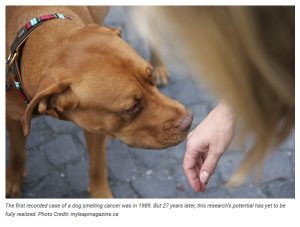
(DOGS) Dogs possess an impressively strong sense of smell. They are used as service dogs because of this particular ability, which helps in bomb detection, disease identification, and so on. They can even smell the amino acids that are absent from their diets and may push aside the food bowl.
Quite recently, the talk of the town was that dogs could smell cancer in humans at the earliest stage. A dog is guided by the power of his olfactory cortex rather than visual cortex. He explores the world by the delightful scents rather than attractive colors. A dog can smell roses and leaves, but cannot see their pretty colors.
The Smelling Capacity of Dogs
The olfactory cortex of dogs is 40 times greater in size than that of humans. It has 125 to 220 million receptors of smell that are highly reactive. Thus, a dog’s smelling capacity is around 100,000 times superior to humans.
So, there’s a possible indication of skin cancer if your pooch suddenly starts to lick you at a specific spot. However, there are many different reasons why your dog licks you, so make sure to research thoroughly. For detection of other cancers, urine and breath samples are often sniffed out by trained dogs.
Can Dogs Smell Lactose Intolerance?
There’s no study proving a dog’s ability to smell lactose intolerance in fellow pooches. Lactose intolerant dogs usually have a low concentration of lactase, the enzyme involved in breaking down lactose.
The milk of a female dog has 3 percent lactose, which is lower than the 5 percent lactose present in cow’s milk. So, re lactose intolerant dogs will typically show symptoms of stomach disorders after consuming lactose-containing dairy products.
Most of the time, dogs lose the ability to break lactose after puppyhood.
How Can Dogs Smell Cancer?
Cancerous cells discharge metabolic wastes that differ from those of healthy cells. Dogs can smell chemical traces in part per million. Dogs can detect a minor difference in odor, which makes cancer detection easier at the earliest stage.
Besides the innate smelling capacity of dogs, dog’s noses are supported by the Jacobson’s organ, located inside the nasal cavity and opening into the upper part of the mouth. This dual smelling capacity helps trained dogs detect cancer’s peculiar odors containing volatile organic substances.
Over thousands of years of research, we found this unique innate ability in dogs. In 1989, the doctors at King’s College Hospital in London talked about a woman whose dog excessively and consistently licked a mole on her leg. The mole was found to be a first-stage malignant melanoma.
Studies since then have proven that dogs can detect cancer from urine odor, skin lesions, and human breath. Dogs can detect specific types of cancer in humans, including but not limited to skin cancer, bowel cancer, ovarian cancer, bladder cancer, prostate cancer, and lung cancer.
How Dogs Assist Cancer Researchers
In a British Medical Journal, one study confirmed that trained dogs can detect bladder cancer with an accuracy of 41 percent by sniffing the patient’s urine. In 2003, acupuncturist Micheal McCulloch conducted a study showing that dogs have the ability to detect lung cancer and breast cancer with an accuracy of 99 percent and 88 percent respectively.
However, there’s no evidence of dog’s detecting cancer in fellow dogs. For treating cancer, auto immune diseases, etc., prednisone is used. Read more about benefits and side-effects of prednisone here.
Dogs’ cancer-detecting ability is enhanced greatly after some training. Trained dogs are recommended to be confined to laboratories. Medical labs have gas chromatographs that are used to separate cancerous compounds for quick identification of cancer. These dogs are typically kept in the loop of patient care to detect the increasing or decreasing number of cancer cells and symptoms.
Recent advancements in cancer detection are creating a breathalyzer that changes color as soon as it comes in contact with cancerous compounds commonly found in human breath. Besides this, electronic noses are also developed to detect cancer and are used specifically in medical science laboratories.
Final Words
With the growing rate of cancer patients globally, it has become a huge concern for all of us. After a multitude of studies and evidence, it’s clear that dogs can smell cancer in humans, not in dogs. On the other hand, lactose intolerance cannot be detected by dogs themselves; we have to recognize the symptoms ourselves and discontinue lactose-containing dairy products.
— Fiona Appleton, exclusive to Global Animal
Fiona Appleton is a Labrador mom, and the manager of Ultimate Home Life, which was developed to help people solve their pet problems. She is an active advocate of animal protection campaigns, and wants people to understand that dog behavior is reflective of human behavior.








